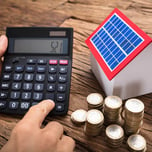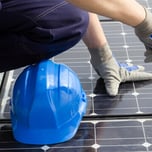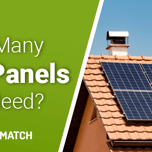
Get up to 4 quotes by filling in only 1 quick form

Slash your energy bills by installing solar panels

We’ve helped over 500,000 homeowners reduce their carbon footprint
- GreenMatch
- Solar Energy
- Solar Panels
Solar Panels for Your Home: A Complete Guide (2024)
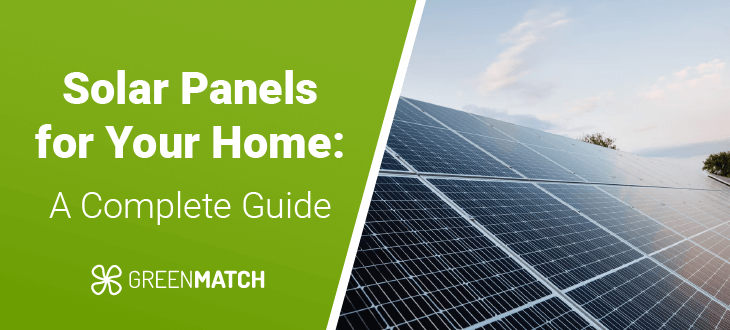
Have you been itching to learn all about solar panels for your home? These solar-powered devices transform solar energy into electricity or heat, which means they can power your household in an efficient and environmentally friendly way.
In this article, we’ll walk you through everything you should know about residential solar panels, including the available types, their pros and cons and the best systems for your home.
First, let’s briefly look at the most important things you should know. We’ll go into more detail later on in the article.
Are solar panels worth it?
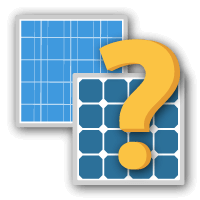
The investment in solar panels is worth it for the average UK home, as residential solar panels can cover 117% of your electricity demand in perfect conditions.
In fact, A 4kW solar panel system can save the average home an estimated £933 every year just in electricity costs. By selling your excess electricity back to the grid on top of that, your payback time could be reduced to six years.
Costs

The average prices of domestic solar panel systems in the UK range between £5,000 to £11,000, depending on how many panels you need for your home, which in turn is dependent on your energy consumption. GreenMatch’s research shows that most UK homeowners will spend between £6,000 to £8,000 on average.
Additionally, if you’d like to store your excess energy, you’re likely to spend between £1,200 to £6,000 on a solar battery, depending on its size and capacity. Although, if you’re looking for something more extensive prices can be higher if you’re looking to buy some of the best solar battery storage in the UK.
Grants

You can break even on your solar panel investment faster with grants. Currently, there are several schemes available depending on where you live.
As of 2023, the 0% VAT, Smart Export Guarantee (SEG), which allows you to receive payments for selling surplus energy back to the grid, and Energy Company Obligation Scheme (ECO4), which permits low-income households the opportunity to replace their inefficient heating system with a more efficient and environmentally friendly system, are available in England, Scotland and Wales, among others.
Efficiency

Most domestic solar panels in the UK are around 15-20% efficient, which means they perform the same in the UK as in the rest of the world. This is enough to dramatically reduce your energy bills and carbon emissions.
Seasonality
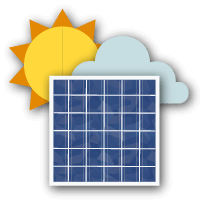
For most of the year (including the winter), UK weather is ideal for the efficiency of solar panels. Solar panels produce enough energy to power 33-51% of a home during the winter period. If you have a solar battery, you could even store your excess electricity for a dark, wintery day and give that percentage a boost.
Warranty

The warranty for solar panel systems generally lasts 25-30 years, with some manufacturers even offering lifetime warranties ensuring that the power input of your panels doesn’t ever dip below 80% of their initial efficiency.
Are you ready to reap the benefits of the points above? Simply click on the button below to get your best solar deal now.
- Quotes from local engineers
- Payment by finance available
- Save up to £729 per year
It only takes 30 seconds



In this article, we’ll dive into everything you need to know about solar panels and explore the topics above in further detail.
- Solar Panels for Your Home: A Complete Guide (2024)
- Are solar panels worth the investment?
- Are solar panels the right choice for your home?
- How do solar panels work?
- Are solar panels efficient in the UK?
- Cost of solar panels based on system size
- Pros and cons of solar panels in the UK
- What types of solar cells are there?
- 10 best solar panel systems for a UK home
- 7-Step domestic solar panel installation guide
- Do solar panels affect house insurance?
- How can you find the right supplier?
- Frequently Asked Questions
Are solar panels worth the investment?
Yes, solar panels are worth the investment for the average UK home in almost all cases. This depends on your energy usage and how much sunlight your home receives.
The answer to this question can be better explained by using a 4kW solar panel system example – the most popular system size in the UK, according to GreenMatch’s research.
A 4kW solar panel system can save an estimated £729 every year for the average home just in electricity costs. By taking advantage of the SEG and selling excess energy generated, you could potentially earn an additional £38.5 per year taking into account an anual energy consumption of 2,700kWh paired with a solar panel generation of 3,400kWh per year and the current SEG tariff rate of 5.5p per kWh for exported energy.
All in all, your payback period could go down to just 6 years. From then on, you’d be profiting from your savings.
Approximately 80% of households with solar systems have a 4kW system. It has an output of 3,400 kWh per year and costs approximately £7,000. If you compare this to the average annual electricity consumption of a household, which is around 2,700 kWh according to Ofgem, residential solar panels can cover 117% of your electricity demand in perfect conditions.
Other factors that affect whether solar panels are worth it include the following:
- Performance all year round. While your panel outputs will peak during summer due to more sunlight, you’ll still be benefitting from your panels in the winter. In fact, the farther south you are in the UK, the higher the year-round output you’ll generate.
- Financial incentives. The UK Government also recognises the value of solar panels and has backed financial incentive programmes to increase solar panel adoption rates. For instance, the Smart Export Guarantee (SEG) helps you earn money for any surplus solar energy you generate by exporting it back to the national grid.
Because of these factors, despite the initial solar panel installation cost, many homeowners find that using renewable solar energy and taking advantage of SEG makes solar panels worth it because they can recoup their costs faster.
Are solar panels the right choice for your home?
Solar panels are suitable and fit for most homes in the UK. In fact, nearly 12,000 solar panels are installed in the UK each month according to national government statistics.
You can easily find out if solar panels are suitable for your home by using the checklist below.
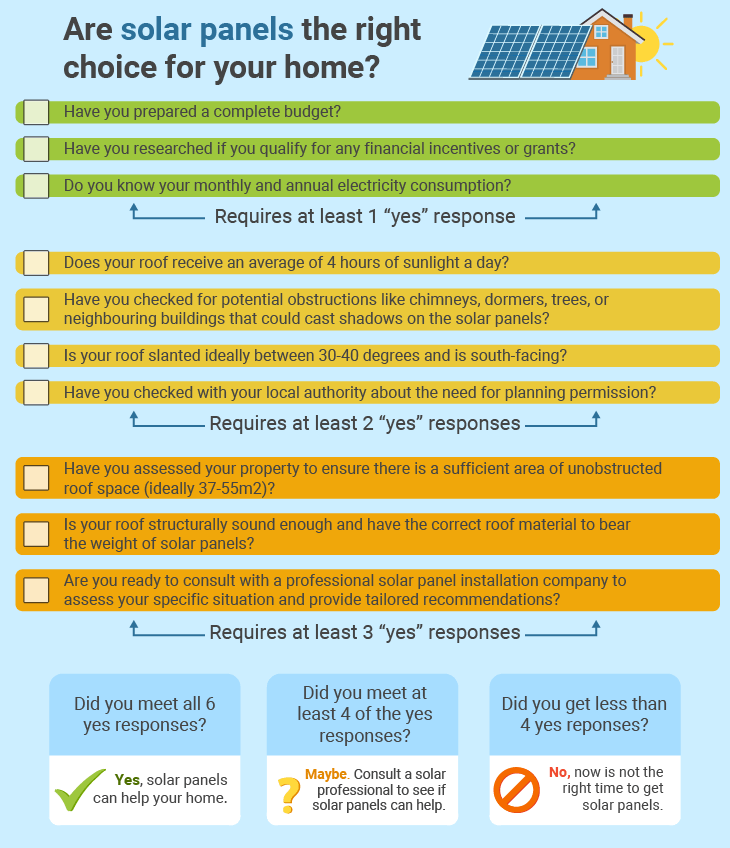
- Answered yes to all the questions in the checklist? Great! You’re ready to start talking with a professional solar panel installer.
- Didn’t answer yes to all questions or didn’t know the answers? Don’t worry. A solar professional can still help you decide if your home could benefit from solar panels. Otherwise, they can provide you with a roadmap for how to improve your home to be suitable for solar panels.
Some of the elements in the checklist are more lenient than others. For instance, while you should ideally have a slanted roof facing south, you can still install flat roof solar panels. You may just experience a lower electricity output.
However, there are some hard requirements that cannot be negotiated when getting solar panels, such as:
- Having sufficient roof space. Solar panels can take up a significant amount of roof space. You will need at least 30 cm of space around your solar panels. While you can opt for a smaller solar panel size or fewer solar panels to decrease the amount of space needed, you’d be compromising on your electricity generation needed to meet your demands. That could alter how beneficial solar panels are for your home.
- Having a structurally sound roof. Your roof needs to handle the weight of a solar panel system. Nowadays, most materials are suitable to hold solar panels — it’s only slate and wooden roofs that may be too brittle. But if your roof is old or is showing signs of damage, such as cupping or lifting, then it may be time to replace or repair it before installing solar panels.
- Consulting with a professional installer. Once you’ve decided to get solar panels, choosing an MCS-registered installer who can consult and advise on your specific home situation is crucial. Their industry experience and ability to provide personalised recommendations can help save you time and money in the long run.
Many people find the next step of finding a trustworthy solar professional to be a daunting task, which is why we’ve partnered with a network of vetted and trustworthy installers and have got the entire process down to just a few simple steps.
- Fill in the 30-second form to let us know what you’re looking for and the condition of your home.
- We’ll call you to confirm your details and you’ll receive up to 4 different quotes from local installers.
- You’ll compare the different quotes and choose the best one that fits your budget and needs. This entire service is free and comes with no obligation to accept any of the quotes you receive.
Click the button below to start getting up to 4 free quotes with our 30-second form.
- Quotes from local engineers
- Payment by finance available
- Save up to £729 per year
It only takes 30 seconds



How do solar panels work?
When speaking about solar panels, it is important to distinguish between two main types:
- Photovoltaic panels that produce electricity
- Solar thermal panels that are used for heating purposes
Solar photovoltaic panels
With over a million photovoltaic (PV) systems deployed in the UK, they are a commonly used solar panel system in the UK. Photovoltaic systems convert sunlight directly into electricity.
Solar cells are made of semiconductors, such as silicon, which absorb the sunlight and convert it into electricity.
Solar cells are connected electrically and packed together in a frame, commonly known as a solar panel. When you connect multiple solar panels together, they form a solar array. And, finally, when you add the cabling, brackets, inverter, and so forth, the entire system forms your solar panel system.
The electrical conductors are attached to positive and negative terminals, thus forming an electrical circuit. From there, the electrons can be captured in the form of an electric current (electricity). This current, together with the cell’s voltage (which is a result of its built-in electric field or fields), defines the power (or wattage) that the solar cell can produce and is how solar panels convert sunlight into electricity.
Grid-connected vs. stand-alone PV systems
Grid-connected systems make use of the local utility grid to ensure you are never without electricity. If your residential solar panel system generates more electricity than your household requires in a day, this surplus energy can be exported back to the national grid. On the other hand, if you need more electricity than your solar panels have generated, the grid can supply this.
Stand-alone PV systems are not connected to the grid but instead, charge a solar battery system. These batteries store the electricity generated by your panels. To operate your appliances, the stored electricity from these batteries will be used. Stand-alone systems are used in areas that cannot be connected to a grid and are typically more expensive than grid-connected systems because solar batteries are still quite costly.
Solar battery storage systems
Solar batteries store electricity generated by solar power and let you use it during the evenings when your solar panels are not generating electricity. You can make use of solar batteries whether you are connected to the grid or not.
Solar battery prices are not low, ranging from £230 to £10,000, depending on the size and capacity. However, technological advancements are leading to new solutions year after year, and may likely lead to a reduction in solar battery prices.
Solar Thermal Collectors
Solar thermal panels use sunlight to heat up water that is stored in a cylinder, which can then be used for your home heating needs. Solar thermal panels are roof-mounted, just like electric solar PV panels, but look slightly different, as instead of cells they have multiple pipes that heat up water. A related technology is thermodynamic panels, which extract heat from the ambient air.
Both solar thermal and thermodynamic panels can be used for space heating, but most commonly they provide the domestic hot water (DHW) needs of households.

Already have an idea of what you’re looking for and don’t want to waste any more time? Simply click the button below to get up to 4 of the best solar panel quotes. It’s completely free and you’re under no obligation to accept any of the quotes you receive.
- Quotes from local engineers
- Payment by finance available
- Save up to £729 per year
It only takes 30 seconds



Are solar panels efficient in the UK?
Most solar panels on domestic systems in the UK are around 15-20% efficient, although some types of solar panels can reach an efficiency level of up to 25%. A typical commercial solar module has an efficiency rating of 15-20%. The efficiency refers to the amount of sunlight that gets converted into electricity versus the amount of sunlight reflected on the panels.
While the average efficiency rating of 15-20% may seem low, it’s the same as in the rest of the world. Only a certain portion of the solar spectrum can be converted into electricity, which means that a sizable chunk is lost as heat. Despite this, a 4kW solar panel system can generate enough electricity to dramatically reduce one’s energy bills and carbon emissions. Solar panel efficiency is likely to increase even more due to advances in technology, but the panels will never be 100% efficient.
Naturally, there are many factors that can affect the efficiency of your system, from the type of solar panel to angling, and seasonality.
In terms of seasonality, while solar panel efficiency is higher on sunny days, solar panels do not need direct sunlight to work, as they can also produce a considerable amount of electricity on cloudy days and during the winter season. In fact, efficient solar panels are more suited to cooler temperatures and can overheat in countries with very warm weather.
Therefore, for most of the year, UK weather is ideal for the efficiency of the product. Solar panels can be effective even in the winter if you prepare and maintain them properly.
A phenomenon known as the ‘albedo effect’ causes solar panels to be highly effective even in snowy climates. The white colour of the snow actually reflects sunlight, therefore, more electricity can be produced — the same way skiers and snowboarders can get easily sunburnt on the pistes. Naturally, the snow needs to be cleared off the solar panels first in order for the system to work. If your panels are covered by anything, it will reduce their efficiency.
The image below shows the average energy output produced throughout the year by a south-facing 4kW domestic solar panel system on a roof angled at 40 degrees. Solar panels produce enough energy to power 33-51% of a home during the winter period.
The power of solar panels is measured in kilowatt-hours (kWh). To find the average energy output, add the minimum figure and the average figure. To find the maximum output, add all three together.
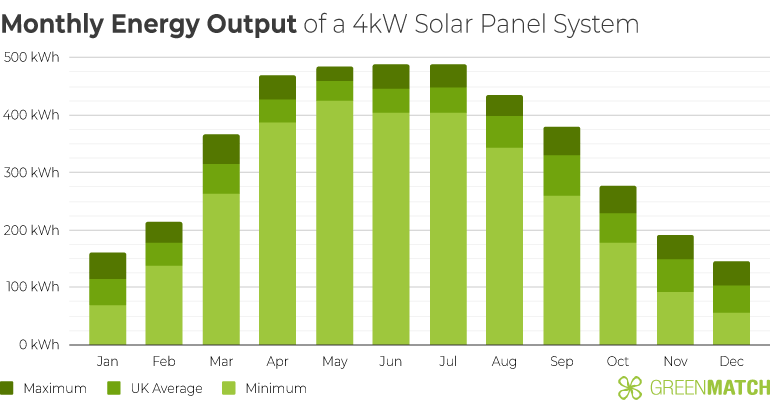
Each region in the UK has varying degrees of sunlight, so we have broken down the average monthly energy output per major city in distinguished regions to give you a better idea of potential energy output.
You can save varying amounts of money depending on the region you’re in. In London, for example, you can save an average of £175 – £420 on yearly electricity bills. In other areas like Stirling or Manchester, you can reduce your bills by £165 – £405 per year. These savings figures also depend on whether you use the Smart Export Guarantee and how much time you spend at home (Energy Saving Trust).
4 main factors affecting solar panel efficiency
To get the most out of your solar panel system and thus cut your expenditure on utility bills, maximising your solar panel efficiency is crucial. The key factors that affect the efficiency of the panels are:
- The location, angle and direction of your solar panel system
- The type of solar panel system you own
- The solar panel maintenance that has been carried out
- The age of your solar panel system
Let’s have a look one by one.
1. Location, angle, and direction
The sunlight exposure of your solar panels is dependent on your roof’s suitability. In the UK, you want to ensure that your solar panels are exposed to sunlight from 9 am to 3 pm.
The optimal direction for solar panels is south-facing, as it would mean the panels are exposed to sunlight for as long as possible. According to Stanford University, a 34° roof tilt angle is the best position for solar panels in the UK.
| Roof Angle | Orientation | ||||||
|---|---|---|---|---|---|---|---|
| North West135° | West90° | South West45° | South0° | South East–45° | East–90° | North East–135° | |
| 0° | 83.5% | 83.5% | 83.5% | 83.5% | 83.5% | 83.5% | 83.5% |
| 15° | 73.6% | 83.5% | 90.2% | 93.7% | 90.8% | 83.0% | 74.3% |
| 30° | 64.0% | 79.4% | 93.3% | 99.3% | 94.5% | 81.2% | 65.4% |
| 34° | 61.7% | 78.4% | 93.5% | 100.0% | 94.8% | 80.4% | 63.1% |
| 45° | 55.6% | 75.1% | 92.5% | 99.9% | 94.1% | 77.3% | 56.9% |
| 60° | 47.4% | 68.7% | 87.5% | 95.7% | 89.4% | 70.7% | 48.3% |
| 90° | 30.3% | 49.6% | 66.1% | 72.6% | 67.8% | 50.5% | 30.7% |
If your roof doesn’t have the optimal orientation and angle, you can install brackets to adjust the angle slightly. However, get this assessed by a certified MCS installer.
If a home is non-optimal (e.g. has partial shading from trees or a weird roof angle), a homeowner can maximise the electricity out of their array by using either microinverters or DC optimisers, rather than conventional inverters that are better for large-scale solar farms. Most solar installers would offer one or both of these options as it avoids losses during partial shading. You can also use Google Sketchup to see how big of a deal trees are at your house.

Joshua M. Pearce is the John M. Thompson Chair in Information Technology and Innovation. He holds appointments at Ivey Business Schooland the Department of Electrical & Computer Engineering at Western University. He runs the Free Appropriate Sustainability Technology research group.
2. Type of solar panel system
While all solar panel systems can bring down your electricity bill and carbon emissions, some types of systems are more efficient than others.
| Type of solar panel | Efficiency (%) |
|---|---|
| Monocrystalline | 15-20% |
| Polycrystalline | 15-17% |
| Thin-film | 15-20% |
Out of the most common solar panel types, monocrystalline panels are known to be the most efficient type on the market. This means that you will require fewer panels (and therefore less roof space) to generate as much electricity as other types of systems.
Polycrystalline solar panels, on the other hand, have a slightly lower efficiency rate, while thin-film solar panels are efficient, but also degrade faster than the other two types.
3. Maintenance
It’s important to carry out the right solar panel maintenance to maximise the lifespan of your system, as this can directly impact their efficiency. Fortunately, solar panels do not require much maintenance throughout their lifespan of 25-30 years.
Get your panels checked regularly by your installer or by another certified service provider. If you do this yourself, you may void your warranty in case you damage your panels in the process.
What you can do yourself is ensure your panels are clean at all times, as objects obscuring the panels will negatively impact their efficiency. This involves removing leaves and branches from your solar panel system, and rinsing them down with a garden hose – avoid sponging them down or touching them.
4. Ageing
Solar panels will eventually age with time, which directly affects their efficiency. Generally, the efficiency of a panel will decline by roughly 0.5% per year, with a larger jump after the first year. This depends on the type of solar panel you choose.
However, most solar panel manufacturers will offer warranties that ensure that even after 25-30 years, the power input of the system will stay over 80% of its original efficiency. There are even manufacturers that offer a lifetime warranty, which ensures that you can reap the benefits of your solar panels for many years to come.
How many solar panels do you need for your home?
| How many solar panels do I need? (by house size) | |||
|---|---|---|---|
| House size | Solar PV system size | Number of solar panels (250W) | Number of solar panels (400W) |
| Flat or 1-bedroom house | < 2000 kWh | 2 – 4 | 2 – 6 |
| 3-bedroom house | 2000 – 4000kWh | 4 – 6 | 6 – 11 |
| 4 or 5-bedroom house | 4000 – 6000kWh | 7 – 9 | 11 – 16 |
| 5+ bedroom house | 6000 – 8000kWh | 10 – 15 | 16 – 21 |
Your roof size determines the number of panels that can fit on your roof, how much energy can be generated.
A 4kW solar panel system would require approximately 16 solar panels with a 250W power output. This would require around 25.6 m² of roof space. A 5kW system comprises 20 solar panels, requiring 32.0m² of roof space.
As these factors differ from home to home, it is important to assess each household uniquely.
The first step to finding how many solar panels you need is to identify your current energy consumption. You measure this in kilowatt-hours (kWh), and it’s important to take the time needed to calculate this as accurately as possible.
- Check your electricity bills to get your power consumption (in kWh). You can either calculate month by month or add your monthly/quarterly consumption together for an annual figure.
- Decide on how much of your electricity bills you want to cover with your solar panel usage — this can be anything from 10-100%. Your decision will affect the system size and costs.
- Calculate how many solar panels actually fit your roof. An average solar panel takes about 1.44 m2 of roof space. Don’t forget to include at least 30 cm from the roof’s edge. Adjust the system size if you realise that you don’t have enough space for all the panels you calculated.
Cost of solar panels based on system size
The average domestic solar panel system costs £5,000 to £11,000. The total cost of solar panels depends on how many panels you need for your home, which in turn is dependent on your energy consumption.
Generally, the more expensive the system, the more electricity it can generate — and therefore, the more savings it can bring. The table below shows the annual savings on your electricity bills per system size, how much you can earn through Smart Export Guarantee (SEG) payments, and ultimately, how long it can take to break even.
| Household Size | System Size | System Cost | Annual Savings on Electricity Bill | SEG Payment | Break-Even Point |
|---|---|---|---|---|---|
| Small | 3kW | £5,000‑£6,000 | £486 | £41.25 | 12 years |
| Average | 4kW | £6,000‑£8,000 | £729 | £38.5 | 10 years |
| Large | 6kW | £9,000‑£11,000 | £1,107 | £55 | 9 years |
A small house with 1-3 residents can sufficiently cover their electricity costs with a 3kW solar panel system, which costs £5,000-£6,000. With that system, you can save £486 per year on your electricity bill thanks to the free energy produced by your panels. Whether you can earn money through the SEG depends on your household’s electricity usage and how much you would like to export back to the grid.
A household with a family of 3-4 people would commonly have a 4kW system installed, which has a price range of approximately £6,000-£8,000. In this scenario, you can save approximately £729 on your electricity bill annually, and can even earn £38.5 per year on top of that.
For larger homes that house 4+ people, a 6kW solar panel system would be required. This can be anything from about £9,000 and upwards. With a 6kW system, you can save a whopping £1,107 on your electricity bills every year and potentially earn £55 from SEG payments additionally depending on how much electricity you choose to export.
Nonetheless, you are not limited to these three choices only. The system size is determined by the number of panels and the wattage of each panel; as a result, you can customise the system size according to your needs, e.g. have a 3.5kW solar panel.
If you are installing commercial solar panels then the sizing will be vastly different, and this will be reflected in the cost.
As you can see, the number of panels will affect both the solar panel system capacity and its costs, so determining the correct number for your home is of utmost importance. When buying and installing solar panels for your home, we strongly recommend contacting certified local installers and comparing their quotes to get accurate indications and also the best value for your money.
There are two ways of doing this: The easy way and the hard way. The hard way involves calling up all of your local solar panel installers, explaining your energy demands, and requesting a tailored quote. But why spend hours doing all that when the easy way is as easy as completing a 30-second form to get up to 4 tailored quotes?
GreenMatch’s free quote comparison service has streamlined the easy way so that getting solar panels is easier than ever. Just click the button below to start getting free, no-obligation quotes.
- Quotes from local engineers
- Payment by finance available
- Save up to £729 per year
It only takes 30 seconds



Is it worth getting solar panels?
With SEG earnings, you can break even with solar panels much faster, making electric solar panels financially worth it — in addition to the obvious environmental benefits. Furthermore, with continuous improvements to technology, solar panels are becoming increasingly affordable.
Keeping in mind the cost, savings, and earnings mentioned earlier, you can break even on your solar panel investment within the system’s lifespan.
For example, with a 3kW system, you can break even after 12 years. With a 4kW system, you can break even already after 10 years. Finally, with the larger 6kW system, you can break even after 9 years.
So if you’ve ever asked yourself “are solar panels are worth it“, the answer is: yes, they are.
Is it worth buying cheap solar panels?
Solar panels can indeed be expensive, and some will want to find the cheapest solution. Cheap solar panels can make the setup costs more affordable, but they may not be worth it in the long run. After all, investing in solar energy is a decision with long-term implications. Cheap solar panels are likely to have a shorter lifespan and lower efficiency, and for that reason, your savings might be less significant.
When considering installing solar panels in your home, solar panel prices should not be the only factor. It will pay off, in the long run, to invest in high-quality panels and especially in a premium inverter from an MCS-certified installer that has a good reputation in your area.
Are there grants for solar panels in the UK?
In the UK, you can earn money on your solar panels through various solar panel grants and financial schemes depending on where you live. See the table below for an overview.
| Solar Panel Grant/Scheme | Eligible Regions |
|---|---|
| 0% VAT | England, Scotland, Wales |
| Smart Export Guarantee (SEG) | England, Scotland, Wales |
| ECO4 (Energy Company Obligation Scheme) | England, Scotland, Wales |
| Home Upgrade Grant | England |
| Home Energy Scotland Programme | Scotland |
| Warmer Homes Scotland | Scotland |
It’s important to consider that not all of the active grants and financial schemes are available across the entire UK. We’ve included the top 6 grants for you to consider. Most notably, the 0% VAT, ECO4, and the Smart Export Guarantee (SEG).
Since the 1st of January 2020, the Smart Export Guarantee has effectively replaced the Feed-in Tariff (FIT). With the SEG, UK homeowners can earn money by exporting surplus energy back to the grid.
The SEG requires that all energy suppliers with over 150,000 customers must offer a tariff for electricity sold to the grid. Individual energy suppliers can set their own tariffs, but as of 2024, a good export tariff rate is 4-6p/kWh. However, you may find some that go as high as 24p/kWh.
Another option for solar panel funding is the new VAT reduction on energy-saving products, such as PV panels. This means that, until March 2027, you’ll pay 0% on VAT to help homeowners transition to renewable energy. You could potentially see up to tax savings worth £1,000. If you qualify, your solar panel installer should automatically apply this VAT reduction.
You can also consider the ECO4 Scheme if you’re eligible. With ECO4, low-income households can replace an inefficient heating system with a more efficient and environmentally friendly system, such as solar PV panels. Part of the requirements is that you need to be receiving government benefits to qualify. If you’re not on benefits, you could also consider the ECO4 LA Flex which has less strict requirements.

Pros and cons of solar panels in the UK
There are many advantages of solar panels, and they play a significant role in the progress towards sustainability. As of 2024, the UK generates 7.8% of its total electricity using solar power, and there are currently more than 1 million solar PV installations. The UK’s solar capacity is only going to increase over the years.
Besides being environmentally friendly, solar cells provide significant savings on your electricity bill. While there are disadvantages to solar panels, the long-term benefits of investing in solar far outweigh the cons.
There has been a slight increase in sunshine hours over the years, meaning you can get more and more out of your solar panel investment. The graph below shows the gradual increase in sunshine hours in the UK.
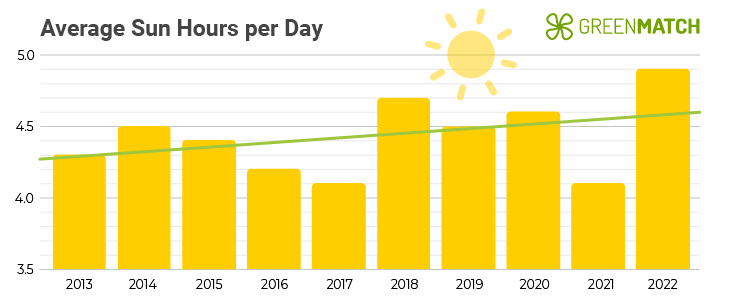
Solar panels can be a great way to cover your household electricity demands free of charge. However, there are downsides to solar panels that must also be considered. Below is a list of the main advantages and disadvantages of this renewable source of energy.
Advantages of solar panels
- Cheaper electricity bills
- Earn money back
- Reduce your carbon footprint
- Year-round efficiency
- Low maintenance
- Independent from the grid
Cheaper electricity bills
With an increase in electric gadgets comes an increase in utility bills. You can reduce your electricity bills by incorporating solar panels into your household.
The energy produced by solar panels is completely free, and surplus energy can always be stored for future use, or exported back to the grid.
Earn money back
With the Smart Export Guarantee (SEG) you can make money by selling surplus electricity back to the grid. The SEG requires that all energy suppliers with 150,000 or more customers must offer an export tariff to homeowners, and the tariff must be above zero.
This means that small-scale solar PV generators will be able to see a return on their investment. However, only new installations can register for the SEG, while those already signed up under the Feed-in Tariff will be bound to those conditions.
Year-round efficiency
Solar panels can work efficiently all year round. While they work optimally during the sunny months, they also produce a considerable amount of electricity during cloudy days and in the winter time.
“Contrary to common belief, solar panels do not need heat to be effective. They simply need sunlight. That means solar panels can be effective even on cloudy days, and certainly during the winter months, too!”
Low maintenance required
Solar panels have an average lifespan of 25-30 years and require only little maintenance over these years. A good quality inverter might need to be changed every 10-15 years, but apart from that, you can enjoy the solar benefits under normal conditions.
It is a good idea to have your installer come and inspect your system regularly, in case of any cabling issues or loose brackets.
You should also clean your solar panels regularly, and ensure there are no leaves or branches on them. Roof-mounted solar panels are essentially self-cleaning, as rainfall can help clean the dust off the system.
Finally, ensure that there are no trees casting shadows over your panels, as this would reduce their efficiency.
Independent from the grid
Solar panels are ideal in remote areas where extending power lines to connect with electrical power grids would be too expensive. Solar PV systems are an affordable, effective solution for remote homes in rural areas of the country.
There is also the possibility of integrating solar batteries into your solar panel system. Solar batteries store the energy gathered by solar cells, saving it for rainy days or for use throughout the night.
Although solar panels can be considered expensive, you can generate electricity for free. In addition, making use of incentives like the SEG can lead to an earlier break-even point.
Reduce your carbon footprint
Switching to solar energy significantly reduces your carbon footprint as it is a green, renewable source of energy. Unlike traditional electricity generators, like fossil fuels, coal, and oil, solar power does not release harmful carbon dioxide (CO2) or other pollutants.
Estimates also show that domestic solar panels could save around one tonne of CO2 per year, which means just one installation can offset approximately 25 tonnes of CO2 over its lifetime.
That is the amount of CO2 that around 50 fully-grown trees would take 25 years to absorb. In other words, you can make a difference by going solar! Get started by clicking on the button below.
- Quotes from local engineers
- Payment by finance available
- Save up to £729 per year
It only takes 30 seconds



Disadvantages of Solar Panels
- High initial costs
- Dependent on sunlight
- Specific solar panel placement
High Initial Costs
Investing in solar panels can be expensive. You can expect around £5,000 to £11,000 in up-front costs. Although you can earn money back on your solar panels by exporting energy to the grid, the high set-up costs can be difficult to meet for some.
Significantly More Efficient During Daytime
Solar panels are dependent on sunlight. Although they do not require direct sunlight to work, they lose efficiency if they are not fully exposed to sunlight. In addition, they can’t produce energy during the night and are less effective during dark winters.
An effective solution to this is to switch to the main power grid at night. Alternatively, homes with a grid-independent system can store energy in solar batteries during the day, which can then be used at night.
Solar Panel Placement
Inaccurate placement of even the best solar panels can majorly reduce the effectiveness of electricity generation. If you live in an area surrounded by large buildings or tall trees, the efficiency of your solar panels will be very limited.
Ensure there are no buildings or trees blocking sunlight, and always clear branches and leaves from the panels.
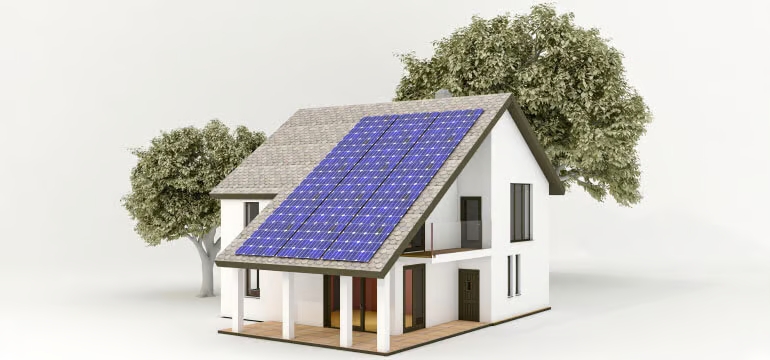
What Types of Solar Cells Are There?
The most common types of domestic solar panels are monocrystalline panels, polycrystalline panels, and thin-film solar panels. There are additional types of solar panels on the market, however, these three are most commonly used for domestic purposes.
These three types of solar panels all produce electricity from sunlight, but it is important to be aware of their key differences.
Monocrystalline Solar Panels

Monocrystalline solar panels get their name because they are made of one piece of silicon. They are known as the most efficient type of solar panel on the market and can be identified by their sleek, black appearance.
When produced, the material that is used is single-crystal silicon, which is then cut into wafers. This allows for the electrons to flow freely, resulting in the high-efficiency rates. This also makes them the most expensive domestic solar panel type.
Advantages:
- They have the highest efficiency rates at 15-20%.
- They are space-efficient, thanks to their high-efficiency rates.
- They perform better in low levels of sunlight than polycrystalline panels.
Disadvantages:
- They are the most expensive silicon solar cells on the market.
- The level of performance suffers as the temperature goes up. However, the loss is still smaller compared to other types of solar cells.
- More waste is produced during the production of monocrystalline panels. As each of the four sides of the cells is cut out, the initial silicon that was used ends up in waste (which, nevertheless, can be used in the production of polycrystalline panels).
Polycrystalline Solar Panels

Polycrystalline solar panels are produced by melting several pieces of silicon together into square moulds, forming the solar cells. As there are multiple crystals in each solar cell, there is less space for electrons to move around, resulting in a lower efficiency rate compared to monocrystalline cells.
Polycrystalline panels are easier to produce than monocrystalline ones, and therefore also cheaper. They usually have a blue appearance, instead of the black hue of monocrystalline panels.
Advantages:
- They are cheaper than their monocrystalline counterparts.
- Less waste is produced during production.
Disadvantages:
- Polycrystalline panels have a lower energy efficiency of 13-16%.
- They are less space-efficient than monocrystalline panels due to their lower energy efficiency. In other words, you need more physical panels to produce the same amount of energy.
- They have a shorter lifespan than monocrystalline panels, as they are slightly less tolerant to temperature increases. In practice, though, this difference is minimal.
When monocrystalline or polycrystalline solar panels reach the end of their lifespan, these solar panels are recycled. 95% of the glass, 85% of the silicon, and all of the metals are reused. This, however, comes at a cost, as high-temperature thermal and chemical processing is used. Thin-film panels can also be recycled with a different industrial process.
Thin-Film Solar Panels

Thin-film solar panels are easier to produce as they require less material. For that reason, they are the cheapest type of solar panel on the market. Thin-film solar panels are made by placing films of one or more PV materials onto a substrate and can be made into a flexible panel. There are various types of thin-film cells, including silicon, cadmium, and copper.
Thin-film panels are the least efficient on the market and require the most space. They are more tolerant to high temperatures, making them suitable for hotter countries.
Advantages:
- They are the cheapest type of solar panel available.
- They can be flexible, making them open to new kinds of applications, such as installing solar panels on motorhomes.
- They are temperature-tolerant.
Disadvantages:
- They are four times less efficient than monocrystalline panels.
- Low energy efficiency also means they are the least space-efficient.
- Thin-film panels tend to have the shortest lifespan of the three types.
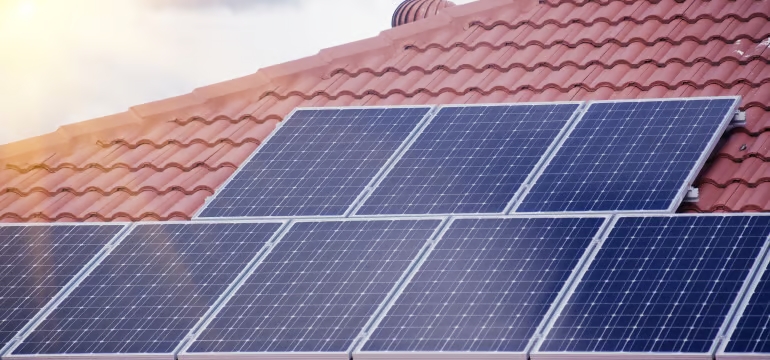
10 Best Solar Panel Systems for a UK Home
It can be difficult to find the best solar panels on the market in the UK, as there are so many different brands and models to choose from. The answer to ‘What are the best solar panels for my home?’ will differ from household to household. It depends on whether you are focused on efficiency, power, size, or durability.
To help you, we have compiled a list of the 10 best solar panels in the UK. Find out more about these systems and their suitability for your home on our ‘Best Solar Panels in the UK’ page.
| Make and model | Power | Efficiency | Temperature Coefficient | Performance Degradation | Maximum Wind Load | Warranty |
|---|---|---|---|---|---|---|
| Project Solar Evolution Titan 445 | 445W | 21.4% | N/A | N/A | N/A | Lifetime (99.9 years) |
| SunPower Maxeon 3 | 400W | 21.2% | -0.27% / °C | 2.0% first year, then 0.2% per year | 4,000 Pa | 40 years |
| Jinko Tiger Neo 420W N-Type 54 Cell | 420W | 21.5% | -0.45% / °C | N/A | 2,400 Pa | 25-30 years |
| REA Fusion Energy Solar Panels | 465W | 22.0% | -0.28 % / °C | N/A | 6,000 Pa | 25 years |
| JA Solar JAM60S20 | 390W | 21% | -0.27% / °C | N/A | N/A | 12-25 years |
| Yingli PANDA Bifacial 72CL | 390W | 20.5% | −0.38% / °C | 2.0% first year, then 0.5% per year | 2,400 Pa | 10 years |
| Sharp NU-AF | 370W | 19.0% | −0.38% / °C | 3.0% first year, then 0.7% per year | 2,400 Pa | 10 years |
| Q. Cells Q.Peak Duo BLK-G6 345W | 345W | 19.3% | −0.36% / °C | 2% the first year, then 0.5% per year | 4,000 Pa | 12 years |
| Amerisolar AS-6P30 | 280W | 17.5% | −0.41% / °C | 2.5% first year, then 0.5% per year | 2,400 Pa | 12 years |
| Sharp SunSnap ND-F2Q235 | 235W | 14.4% | N/A | N/A | N/A | 25 years |
How to Choose the Best Solar Panels (10 Criteria)
There are many factors to evaluate when you are looking for the best solar panels for your home. We have analysed the top 10 solar panels according to the following ten criteria:
- Type: There are two types of solar panels that dominate the market: monocrystalline and polycrystalline.
- Power: The ‘power’ of a solar panel is measured in watts (W). This figure represents the energy output of a panel system in Standard Test Conditions.
- Efficiency: Solar panel efficiency, which is expressed as a percentage, measures how much sunlight can be converted into usable electricity. Most domestic solar panels have an efficiency of 15-20%.
- Power tolerance: This factor determines how much your system can deviate from its stated power (watts). This deviation can be expressed either in percentages or watts. If a 100W panel has a power tolerance of +3% / −0%, then the actual power may vary between 100-103W. If the power tolerance is +5W / −0W, then the actual output varies between 100W and 105W under real-world conditions.
- Temperature coefficient: You want to know how much your panel’s efficiency will be affected by temperature rise. Temperature coefficient expresses the percentage decrease in power output per 1°C increase in temperature (after 25°C).
- Size: If you have limited roof space, the physical size of a panel might be your top priority. The dimensions of the top 10 solar panels are listed in L × W × H.
- Weight: Knowing how heavy your solar panel system will be is important. If your roof is not very strong, you will need to opt for light-weight panels.
- Product warranty: Solar panel manufacturers offer warranties on their equipment, ensuring they can last. Warranties on our list range from 10-25 years.
- Performance degradation: Every solar panel will experience some kind of performance degradation over its 25-year lifespan. After the 1st year, there is usually a 2-3% decline in efficiency, and 0.2-0.7% every year after that.
- Maximum wind load: You want your solar panels to withstand any kind of weather in the UK, including strong winds and hurricanes. This tolerance is tested by manufacturers and is expressed in pascals (Pa). The higher the number, the higher the wind tolerance, but most panels are certified to withstand 2,400 Pa, which is equivalent to 140 mph.
What Are the Most Reputable Solar Panel Manufacturers?
Since the upswing of the use of renewable energy, there has been an increase in solar panel manufacturers on the global market. At GreenMatch, we work with both industry veterans that have been producing photovoltaic modules since the 1960s and new players on the market that are making strides in solar energy technology.
Here is a breakdown of the top solar panel manufacturers currently on the market:
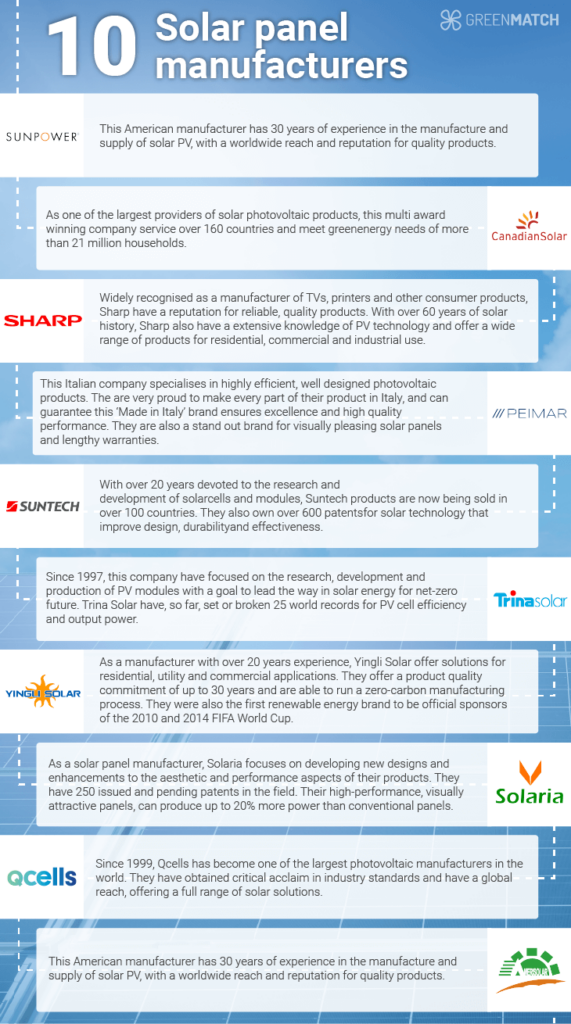
Have any of the solar panel models or manufacturers described so far sparked your interest? Click on the button below, and we will send you up to 4 offers tailored to your requirements from suppliers in your area. You are not obliged to accept any quote you receive.
- Quotes from local engineers
- Payment by finance available
- Save up to £729 per year
It only takes 30 seconds



7-Step Domestic Solar Panel Installation Guide
The solar panel installation process must be done correctly in order to get the most out of your solar panel system, otherwise, your panels will not reach their peak efficiency rate.
In the following video, you can learn more about the solar panel installation process.

Before installing your solar panels, an MCS-certified installer will come and assess your roof. They will look at basic factors, such as roof orientation and angling, roof size, and how strong your roof is (to know how much weight it can hold).
To give you an idea of the solar panel installation process, follow our easy-to-understand 7-step guide:
Step 1: Erect the Scaffolding
To ensure safety for the installation team, scaffolding will be erected around your house.
Step 2: Attach Roof Anchors
After the scaffolding is set up, the installation team arrives. The team starts out by attaching the roof anchors, which will hold the base for the solar panels. The types of anchors used depend on the type of roof tile your home has.
Step 3: Attach the Frame
After the anchors have been installed, it’s time to attach the frame, which is made up of aluminium bars. The bars must be fitted in a straight direction and parallel to one another.
Step 4: Install the Solar Panels
Once the frame has been attached, the installation of the solar panels can begin. The panels are clamped to the aluminium frame — but not too tightly at first, in order to have some space to adjust them slightly later. Once all panels are set up in their position, they are firmly secured to the frame.
Step 5: Wire the Solar Panels
Now that the panels are fastened securely to the frame, the next step is to wire them. In most cases, the panels come wired from the manufacturer. However, these wires must be connected to the inverter, which would typically be in the attic.
The inverter is a component of the solar array that converts the absorbed energy from the panels into AC electricity, which can then be used by household appliances.
Inverters are the component in a solar array with the shortest lifespan. Good quality inverters need replacing every 10-15 years. Solar PV inverter replacement costs range depending on a number of factors but typically start from £500.
During the time of the wiring installation, the electricity supply to the household will need to be shut off.
Step 6: Make Final Connections to the Consumer Unit
After the panels are wired to the inverter, the final connections to the consumer unit will be made. A generation meter will also be connected, which measures how much electricity your panels actually produce. Smart meters and solar panels work together very well and can make meter reading far easier.
Step 7: Test the Solar Panels
After the panels, the inverter, and the generation meter are all wired together, the installation needs to be tested. Once this is complete, the solar panel installation process has been successfully completed.
Do You Need Planning Permissions for Solar Panels?
In England, Scotland, and Wales, you are not required to apply for any planning permissions for most domestic solar panel installations — for both PV and heating installations.
There are, however, restrictions on installations of certain sizes. If your solar panels protrude more than 200mm from your roof, you will need to apply for permission first.
In addition, if your building is within a conservation area, you will need to adhere to some planning permission guidelines.
Do Solar Panels Affect House Insurance?
In most cases, when you install solar panels on your roof, your insurance should cover you under the current terms. However, since a solar panel installation results in a change to the home structure, it is always advised to contact your current insurance provider before proceeding with the installation.
It’s important to note that your home insurance may not include a cover for any damage by your solar panel or theft of the system. Therefore, it’s important to confirm with your insurance provider that your panels will also be covered.
Installing solar panels is a worthwhile investment for both homes and companies. They are eco-friendly, reduce utility bills, and can even be a way for you to earn money back.

How Can You Find the Right Supplier?
Solar panels can be expensive, and you want to be sure you find the right solar supplier for your home. You should compare different solar panel providers and make sure you pick a reliable and certified installer.
Finding the right solar panel supplier on your own means investing a lot of time to do research. You could spend hours trying to find the best deal. We can make this process simpler for you, by providing you with up to 4 quotes from different suppliers in your area. This service is completely free and non-binding.
All you need to do is fill in a simple contact form, and we will then connect you with the most suitable installers near you. You can then compare these and get the best deal on solar panels!
- Quotes from local engineers
- Payment by finance available
- Save up to £729 per year
It only takes 30 seconds



Frequently Asked Questions

Attila is the UX Manager at GreenMatch. He holds a degree in international business with four years of coordination experience in marketing, user experience, and content creation. Attila likes to write about solar energy, heating technology, environmental protection, and sustainability. His and his team’s articles appeared in well-known sites such as The Conversation, Earth911, EcoWatch, and Gizmodo.
 We strive to connect our customers with the right product and supplier. Would you like to be part of GreenMatch?
We strive to connect our customers with the right product and supplier. Would you like to be part of GreenMatch? - Solar Panels for Your Home: A Complete Guide (2024)
- Are solar panels worth the investment?
- Are solar panels the right choice for your home?
- How do solar panels work?
- Are solar panels efficient in the UK?
- Cost of solar panels based on system size
- Pros and cons of solar panels in the UK
- What types of solar cells are there?
- 10 best solar panel systems for a UK home
- 7-Step domestic solar panel installation guide
- Do solar panels affect house insurance?
- How can you find the right supplier?
- Frequently Asked Questions








